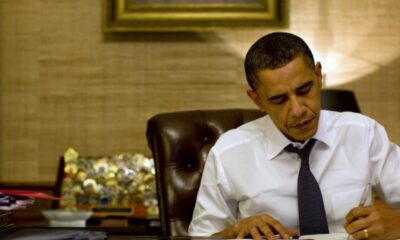Health
The Story of Henrietta Lacks, Mother of Modern Medicine, Is Finally Told
In the 1950s when Henrietta’s cells grew, the concept of informed consent that we have today didn’t exist. People were routinely used in research without their knowledge. Scientists knew very little about the basic functioning of cells—they couldn’t have imagined that someday those cells would be valuable, that someday researchers could look inside them at Henrietta’s DNA and learn things about her and her children and grandchildren.
The story of Henrietta Lacks is still being discussed in TheVillage. The book is now available in paperback, and we have teamed with Random House to offer a copy of the book to the first five subscribers who share the title of their favorite book with us. We also hope you enjoy the excerpt we have included from “The Immortal Life of Henrietta Lacks” (Download a sample chapter (pdf).)
Fill in the form at the bottom of the page, and you’ll be automatically subscribed to our site. We’ll contact you if you are one of the first five.
– – – – – – – – – – – – – – – – – – – – – – – – – – – – – – – – – – – – – – – – – – – – – – – – – – – – – – – – – – – –
Everyone is talking about Henrietta Lacks, the African-American woman whose cancer cells provided the basis for a vast amount of research. She was born in 1920 in Virginia and died in 1951.
But the influence she had on modern medicine made her an unwitting heroine. The VillageCelebration hears from author Rebecca Sklott who wrote the book, The Immortal Life of Henrietta Lacks.
What role did race play in Henrietta’s and her children’s experiences?
This is the story of how cells taken from a black woman without her knowledge became one of the most important advances in medicine and launched a multibillion-dollar industry, with drastic consequences for her family. It’s inextricably linked to the troubling history of research conducted on African-Americans without their consent, and many people—particularly African Americans—are hungry to learn Henrietta’s story and how it fits into that history.
For decades, the story of Henrietta Lacks and the HeLa cells has been held up as “another Tuskegee,” the story of a racist white scientist who realized a black woman’s cells were valuable, stole them from her, then got rich selling them—perhaps even withholding treatment for her cancer in order to be sure the cells would grow. But none of that is true. Henrietta got the standard cervical cancer treatment for the day, and no one knew her cells would be valuable. George Gey gave them away for free and never profited directly from them (they were later commercialized by others). In 1951 when Henrietta showed up at Hopkins, taking tissues from patients without consent had been standard practice for decades. Henrietta’s sample was taken as part of a study on cervical cancer for which researchers were taking samples from any woman who walked into Hopkins with cervical cancer, regardless of race. Henrietta wasn’t targeted because her cells were known to be valuable, or because they were trying to grow cells from a black person. Gey didn’t even know she was black until after the cells grew.
That said, race did play an important role in the story: During the Jim Crow era, Hopkins was a segregated charity hospital—patients in the “public” ward where Henrietta was treated were there because they were either black or poor (often both). They couldn’t get treated elsewhere. And the prevailing attitude at the time was that since “charity cases” were treated for free, doctors were entitled to use them in research, whether the patients realized it or not. Henrietta’s doctor once wrote, “Hopkins, with its large indigent black population, had no dearth of clinical material.” That attitude was widespread at the time.
But this story is just as much about issues of class and economic injustice. Many people have asked me, “Would those cells have been taken from her if she’d been white?” The answer is yes, if she’d been white and poor. Many of the difficulties Henrietta’s family faced came down to issues of class: Their lack of access to education, their inability to afford health care despite the fact that their mother’s cells helped lead to so many important medical advances. The Lacks family often says, “If our mother was so important to medicine, why can’t we get health insurance?” That question gets at the heart of what many readers find most upsetting about the Lacks family’s story.
Was it wrong for the scientists to have taken Henrietta’s cells?
In the 1950s when Henrietta’s cells grew, the concept of informed consent that we have today didn’t exist. People were routinely used in research without their knowledge. Scientists knew very little about the basic functioning of cells—they couldn’t have imagined that someday those cells would be valuable, that someday researchers could look inside them at Henrietta’s DNA and learn things about her and her children and grandchildren. It was a completely different mindset than the one we have now, but it was not ill-intended, or unethical by the standards of the day. George Gey, the scientist who first grew the cells, was devoted to curing cancer. He took cells from himself and his own kids. He never sold the HeLa cells, he never tried to patent them or anything else, including equipment he invented that’s still used around the world that could have made him large amounts of money. Gey was pretty impoverished, but he spent his own money in the lab. Taking cells from patients was absolutely standard practice worldwide in the ’50s. In a lot of ways, it still is today.
Why didn’t Henrietta’s cells die like all the other cells before them?
That’s still a bit of a mystery. Scientists know that Henrietta’s cervical cancer was caused by HPV, and her cells have multiple copies of the HPV genome in them, so some researchers wonder if the multiple copies of HPV combined with something in Henrietta’s DNA caused her cells to grow the way they did. Henrietta also had syphilis, which can suppress the immune system and cause cancer cells to grow more aggressively. But many people had HPV and syphilis (particularly in the ’50s) and their cells didn’t grow like Henrietta’s. I’ve talked to countless scientists about HeLa, and none could explain why Henrietta’s cells grew so powerfully when others didn’t. Today there are other immortal cell lines, and it’s possible for scientists to immortalize cells by exposing them to certain viruses or chemicals, but there still hasn’t been another cell line like HeLa, which grows in a very unique way.
If HeLa cells are cancer cells, how are they useful for research into anything other than cancer, like vaccine production?
Since the ’50s, if researchers wanted to figure out how cells behaved in a certain environment, or reacted to a specific chemical, or produced a certain protein, they turned to HeLa cells. They did that because, despite being cancerous, HeLa still shared many basic characteristics with normal cells: They produced proteins and communicated with one another like normal cells, they divided and generated energy, they expressed genes and regulated them, and they were susceptible to infections, which made them an optimal tool for synthesizing and studying any number of things in culture, including bacteria, hormones, proteins, and especially viruses.
Viruses reproduce by injecting bits of their genetic material into a living cell, essentially reprogramming the cell so it reproduces the virus instead of itself. When it came to growing viruses—as with many other things—the fact that HeLa was malignant just made it more useful. HeLa cells grew much faster than normal cells, and therefore produced results faster. HeLa is a workhorse: It’s hardy, it’s inexpensive, and it’s everywhere. Today, it’s even possible for scientists to genetically alter HeLa cells to make them behave like other cells—a heart cell, for example. So being cancer cells isn’t the limitation most expect that it would be, though there are some things you definitely wouldn’t use HeLa cells for, including any vaccine creation, since you wouldn’t want to inject cancer cells along with a vaccine.
Why was the existence of the HeLa cells so difficult for Henrietta’s family?
The story of the HeLa cells isn’t just about cells being taken from a woman without consent. There’s much more to it: No one told her family that the cells existed until the ’70s, when scientists wanted to do research on her children to learn more about the cells. Her children were then used in research without their consent, and without having their most basic questions about the cells answered (questions like, “What is a cell?” and “What does it mean that Henrietta’s cells are alive?”). This was very frightening, particularly for Henrietta’s daughter Deborah. The science all had a very scary sci-fi quality to it, so she had a very hard time distinguishing what was reality and what wasn’t when it came to science. She worried that there were clones of her mother walking around that she might bump into. And she worried that what the research scientists were doing to her mother’s cells somehow caused her mother pain in the afterlife. She’d say, “If scientists are shooting my mother’s cells to the moon and injecting them with chemicals, can she rest in peace?” For her, these existential questions were really difficult. Other things that the family found upsetting: At one point, Henrietta’s medical records were released to a reporter and published without her family’s permission, which was very traumatizing for her children. Henrietta’s sons were particularly very angry when they learned that people were buying and selling Henrietta’s cells, which helped launch a multibillion-dollar industry, yet her family had no money. To this day, they can’t afford health insurance.
Why is the story of Henrietta Lacks important?
It’s important for a lot of reasons, but perhaps the most central one is that we’re at a time when medical research relies more and more on biological samples like Henrietta’s cells. A lot of the ethical questions raised by Henrietta’s story still haven’t been addressed today: Should people have a right to control what’s done with their tissues once they’re removed from their bodies? And who, if anyone, should profit from those tissues? Henrietta’s story is unusual in that her identity was eventually attached to her cells, so we know who she was. But there are human beings behind each of the billions of samples currently stored in tissue banks and research labs around the world. The majority of Americans have tissues on file being used in research somewhere, and most don’t realize it. Those samples come from routine medical procedures, fetal genetic-disease screening, circumcisions, and much more, and they’re very important for science—we rely on them for our most important medical advances. No one wants that research to stop, but it’s pretty clear that many people want to know when their tissues are being used in research, and when there’s a potential for them to be commercialized. The story of Henrietta, her family, and the scientists involved put human faces on all of those issues, which can be pretty abstract otherwise.
What sparked your curiosity about the woman behind the HeLa cells and made you devote more than ten years of your life to writing this book?
The prologue of the book tells the story of how I learned about Henrietta’s cells for the first time when I was sixteen, but it doesn’t really go into why that story grabbed me to the extent that it did. I think that’s because it wasn’t until after the book was published that I began to understand why the story had such an impact on me. When I first learned about Henrietta’s cells in Mr. Defler’s biology class, the first questions I asked him were whether she had any children, what they thought about Henrietta’s cells living on all these years after her death, and what did the fact that she was black have to do with it all?
I realize now that my questions weren’t obvious ones for a sixteen-year-old to ask, but something was happening in my life that I think primed me to ask questions about the cells. That same year, my father had gotten sick with a mysterious illness no one was able to diagnose. He’d gone from being my very active and athletic dad to being a man who had problems thinking, and he spent all of his time lying in our living room because he couldn’t walk. It turned out that a virus had caused brain damage, and he eventually enrolled in an experimental drug study. Since he couldn’t operate a car, I drove him to and from the hospital several times a week and sat with him and many other patients as they got experimental treatments. So I was in the midst of watching my own father go through research and was experiencing the hopes that can come with science, but also the frustration and fear. It was a frightening time, the research didn’t help him, and in the end the study was dissolved without fulfilling promises it made to the patients about access to treatment. The experience really taught me about the wonder and hope of science, but also the complicated and sometimes painful ways it can affect people’s lives.
I was in the middle of that experience when my teacher mentioned that Henrietta’s cells had been growing in labs decades after her death. So I think I asked the questions I did because I was a kid wrestling with watching my own father be a research subject.
How has the Lacks family reacted to your book?
Henrietta’s children and grandchildren read THE IMMORTAL LIFE OF HENRIETTA LACKS before it came out as part of the fact-checking process. They were very happy with it—they didn’t object to any information in it or ask me to remove or change anything, other than pointing out some dates or other factual things that needed fixing. Naturally some of the book was painful for Henrietta’s children to read, but it was also good for them to read about all of the amazing science that Henrietta’s cells contributed to, which they feel very proud of. For the younger generations of Lackses, it was a way to learn about their history: Their family didn’t really talk about what happened to Henrietta or her children. So the younger generation didn’t know much (if anything) about Henrietta or the cells. They didn’t know what Henrietta had contributed to science, they didn’t know what had happened to their own parents. So finally having the full story has helped make sense of their history—they’re also filled with pride about all that Henrietta’s cells have done for science.
The Lacks family came to a lot of my public events when the book came out—they’d stand up in a room to answer questions, and the crowd would cheer and give them standing ovations. Scientists often stood up saying, “Here’s what I did with your mother’s cells, and thank you, I’m sorry that this has been hard for you and that no one told you what was going on.” Scientists and general readers would stand in long lines waiting for their autographs. The enormous public response to the book has been great for the family—I think there’s been some healing through that process for them.
How has the Lacks family benefited from your book?
The family has benefited from the book in several different ways, including the closure and thanks from scientists that I mentioned earlier. When it came to money, I didn’t want to be another person who came along and potentially benefited from the family and their story without doing something in return. So I set up The Henrietta Lacks Foundation, and am donating a portion of the book’s proceeds to it. The foundation has been in existence since January 2010, and anyone can donate via the foundation’s website (HenriettaLacksFoundation.org). So far donations have come in steadily, ranging from $1 to about $500, with the average being in the $50-$100 range. These donations are from the general reading public and individual scientists who feel that they have benefited from HeLa cells in some way and want to do something in return for the family.
Among other things, the foundation will provide scholarship funds for descendants of Henrietta Lacks, so they can get the education that Henrietta and her family didn’t have access to but desperately wanted. It also aims to help provide health-care coverage for Henrietta’s children. So far the foundation has been able to pay full tuition and books for five of Henrietta Lacks’s grandchildren and great-grandchildren who are now working toward undergraduate, graduate, and trade degrees. It has also provided money for medical assistance for Henrietta’s children and grandchildren. The foundation’s mission is to expand that reach to offer assistance to others in situations similar to the Lacks family.
People often ask if any of the companies or research institutions that have sold or benefited from HeLa cells have given the family any money. The answer is they haven’t, and likely never will. There is concern among research organizations that giving money to the Lacks family would set a legal precedent: If they pay Henrietta’s family for use of HeLa cells, what about the millions of other people whose cells and tissues have been used in research? Who pays them, and how much? One of my hopes in setting up the foundation was that some of those companies and research institutions might feel that donating to a foundation in Henrietta’s name would let them recognize her contribution to science and the impact it had on her family, without concern for setting a legal precedent. So far that hasn’t happened.
Is the Lacks family still angry about HeLa cells?
The Lacks family has gotten to a point where they try to separate what happened with Henrietta’s cells from what happened to them. Henrietta’s cells have been this incredible thing for science and her family really sees that as a miracle, and they’ve gotten to a point now where they can look at them and say, “We think that they’re incredible, and they’ve done wonderful things and that makes us happy. We’re very glad that her cells are out there and being used in the way that they are. We wish it didn’t happen the way that it did. We wish they’d told us, we wish they’d asked, because we would have said yes. We wish they’d explained things to us when we asked, we wish they hadn’t released her medical records.” There were a lot of things they were unhappy about in terms of the way that they were treated, but the way they think about the cells definitely does not reflect a feeling of her being enslaved. It’s more of her being an angel. In life Henrietta was this woman who lived to take care of everybody, and so to the family it makes perfect sense that she’s doing that in death, too. They don’t see the cells themselves as a dark or negative thing.
That said, they are still quite upset about the issue of money, and the fact that others have profited from the cells and her family hasn’t, which is still the case today. The Lacks family is still hoping that Hopkins and the many companies that have profited off of HeLa cells will do something to honor Henrietta and recognize what her family went through.
What messages should be taken from this story?
Some of that depends on each individual reader, because there are a lot of potential messages from the book: It’s about trust, race and medicine, class, access to education and health care, it’s also the story of a family and the impact that losing a mother can have on her children, and much more.
It’s also about the fact that there are people behind every one of the billions of biological samples that are used in research every day. I can’t count the number of emails I’ve gotten from researchers who say that they heard me talking on the radio or read the book and had this very powerful reaction of saying “Oh wow, I had no idea. I did my dissertation on HeLa cells, I work with them every day in my lab—I owe a lot of my career to Henrietta’s cells, and I never once stopped to think about where they came from, whether she had given consent, or whether her family might care about that.” These are questions that scientists don’t often think about. I also hear researchers saying that after learning the story of the HeLa cells, they no longer complain about the regulation of science and the mountains of forms they have to fill out for every study they want to do. In the book, you find out the history behind those forms, why they’re now required, and why it is important. Those are important take-home messages.
But this is also a story about the fact that there are human beings behind every scientist as well. The scientists in the HeLa story have long been demonized in ways that weren’t factually accurate, so I hoped to set that record straight.
How does this story relate to today’s health-care debate?
When you have a biopsy taken at a hospital you sign a form that says your doctor can dispose of your tissues any way he sees fit, or strip them of your identity and use them in research. The attitude has long been that everyone should allow their tissues to be used for the good of science, since the research can lead to medical progress—important drugs, vaccines, etc—from which everyone benefits. But the thing is, not everyone does benefit in the United States, because we don’t have universal access to health care. There is an imbalance in this country, which means many of the medical advances coming from tissue research aren’t available to everyone, sometimes including those who provided raw materials for the research. That’s a pretty stark point in the health-care debate.
From your Afterword on tissue banking and cell culture laws, it really sounds like the same thing could happen today but without the name attached to it. Has anything changed on that front since the book was published?
No, nothing has formally changed in terms of the regulation of tissue research, but there is certainly much more public awareness of the fact that research happens on tissues without consent, and there’s a public discussion happening about this on a much larger scale than has happened before. There also does seem to be a shift happening in the way questions about tissue-research ethics are being handled.
In the Afterword of the book, I wrote about several related court cases that were pending; several of them have since been ruled on in ways that indicate the courts are leaning toward requiring consent. But as of the publication of the paperback edition of THE IMMORTAL LIFE OF HENRIETTA LACKS, there have been no changes in the laws governing tissue research; so as of today there is still no requirement for consent for most tissue research, and the law as I laid it out in the book’s original Afterword is still in place.
 THE IMMORTAL LIFE OF HENRIETTA LACKS
THE IMMORTAL LIFE OF HENRIETTA LACKS
By Rebecca Skloot
Broadway Paperbacks • ISBN: 978-1-4000-5218-9 • $16.00 • 400 pages • Copyright © 2010, 2011 by Rebecca Skloot
—————————————————–

-

 Featured10 months ago
Featured10 months agoCalifornia Is the First State to Create A Public Alert for Missing Black Youth
-

 Featured9 months ago
Featured9 months agoAfrican American Leaders Stay the Course Amid Calls for President Biden To Bow Out of Race
-

 Featured10 months ago
Featured10 months agoThe Debate Fallout Lands on Both Candidates
-

 Featured9 months ago
Featured9 months agoPresident Joe Biden Decides to Withdraw from the Presidential Race
-

 Featured9 months ago
Featured9 months agoIn One of His Final Speeches as President, Biden Says It’s Time for ‘Fresh Voices’
-

 Featured9 months ago
Featured9 months agoPresident Joe Biden Describes Shooting of Donald Trump As ‘Sick’










